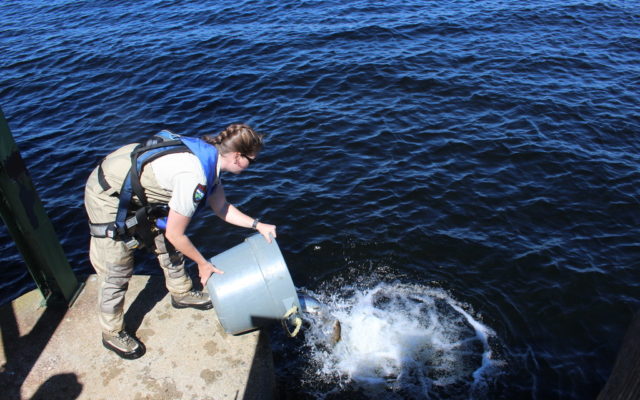
Trapping effort shows wild salmon are thriving in East Outlet of Kennebec River
SAPLING TOWNSHIP — Madison Killian says she uses a pretty simple technique when she’s netting the frisky landlocked salmon that she and her colleagues have trapped in the fishway of the East Outlet Dam.
“You stay kind of cautious and still for a little bit, then you go in and snipe ’em and net ’em right up,” the seasonal fisheries assistant for the Maine Department of Inland Fisheries and Wildlife said. “They will swim away. It’s more luck than anything. They like to try to hide under the fyke.”
Killian is serving the traditional role of the seasonal assistant: She’s the one who hooks up to a safety harness and climbs down a ladder into the last chamber of the fishway, some 10 feet below. Once there, she scurries around the sizeable chamber where fish trying to move into Moosehead Lake from the East Outlet of the Kennebec River have been captured.
Armed with a long net, she puts fish into a bucket, and they’re lifted to the dam’s deck, where DIF&W fisheries biologists wait to sedate and measure the fish. After their data is recorded, they’re revived in fresh water and released into Moosehead.
The goal is to continue to provide a long-term look at the wild reproduction of landlocked salmon in a roughly 3-mile stretch of the river before it dumps into Indian Pond.
Bangor Daily News photo/John Holyoke
FISH SURVEY — Madison Killian, a seasonal fisheries assistant for the Maine Department of Inland Fisheries and Wildlife, dumps a bucket of fish into Moosehead Lake after her colleagues had measured them and recorded the data at East Outlet Dam on July 18.
——————————————————————————————————-
Tim Obrey, the DIF&W’s regional fisheries biologist for the Greenville region, said natural reproduction of fish has been a concern since the dam’s fishway was installed in the late 1950s.
“When the first surveys of the streams around here were done, we found that there was plenty of nursery habitat in the East Outlet, which is boulder and rock where the little salmon like to hang out, but there wasn’t much spawning habitat, which is the gravel,” Obrey said.
Biologists can tell the difference between a wild salmon and a stocked hatchery salmon by looking for fish that are missing certain fins — those fins are clipped for identification purposes at the hatchery. Fish with all their fins still attached are wild fish that hatched from eggs laid in the river.
And through the 1970s and 1980s, natural reproduction in the East Outlet was low, amounting to just a few hundred fish a year, according to Obrey.
Then, during the federal relicensing of the East Outlet Dam in 1998, a pair of spawning channels were created in the river, diverting water along the bank into a gravel-filled sluice for which salmon were looking.
“So now, we’re seeing almost double the wild fish coming up,” Obrey said.
Biologists conduct this research for a six-week span every other year to keep an eye on the river’s natural reproduction. On July 18, 42 of the 56 salmon captured were wild fish. The others were stocked at Indian Pond or in Moosehead Lake.
The biologists typically empty the holding chamber every other day from June 15 until the end of July, when the run of fish trying to get to the cooler water of Moosehead Lake is at its peak.
The crew caught the longest fish of the season — a hefty 22.25-inch wild salmon — but just as important were the 23 tiny landlocks that were heading to the state’s largest lake for the first time. All of those fish, which were shorter than 8 inches long, were wild as well.
It took three trips into the fish-holding chamber to rustle up all of the fish, and Killian admitted after her final netting session that chasing fish around in a confined space can be tiring.
“I’m running around down there. It really gets your heart rate going,” she said with a laugh.
The fact that all of the other biologists spent time as the youngster on the crew, in charge of fish-chasing, means that they all know exactly what she’s going through … and what’s expected.
“Remember, Maddie: No fish left behind,” biologist Jeff Bagley said as Killian tried to track down the final few fish.
“The little ones are harder to chase down,” biologist Steve Seeback, another veteran of the job, pointed out.
Bangor Daily News photo/John Holyoke
LONGEST FISH OF THE SUMMER — Tim Obrey, regional fisheries biologist for the Maine Department of Inland Fisheries and Wildlife, measures a landlocked salmon captured at the fishway of the East Outlet Dam on July 18. Fellow biologist Jeff Bagley (background) records the data. The fish was 22.25 inches long, the longest captured this summer.
——————————————————————————————————–
During the effort a total of 64 fish of all species were caught, a little above the daily average of 50.
And Obrey said the fact 75 percent of the fish were wild provided still more evidence about how much better spawning conditions in the East Outlet have become over the last 20 years.
“When you look at it over the long term, pre-habitat improvement and post-habitat improvement, it’s pretty remarkable,” Obrey said.

